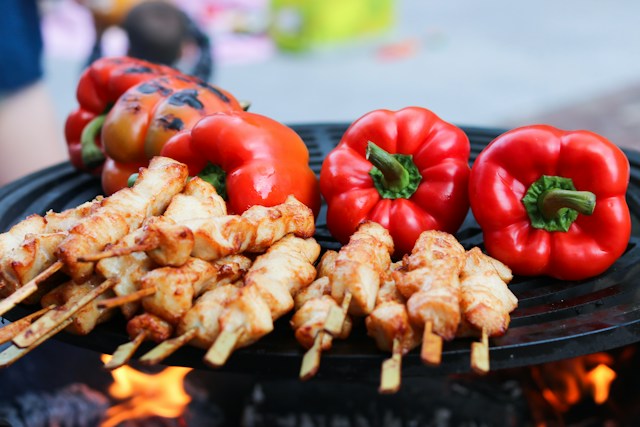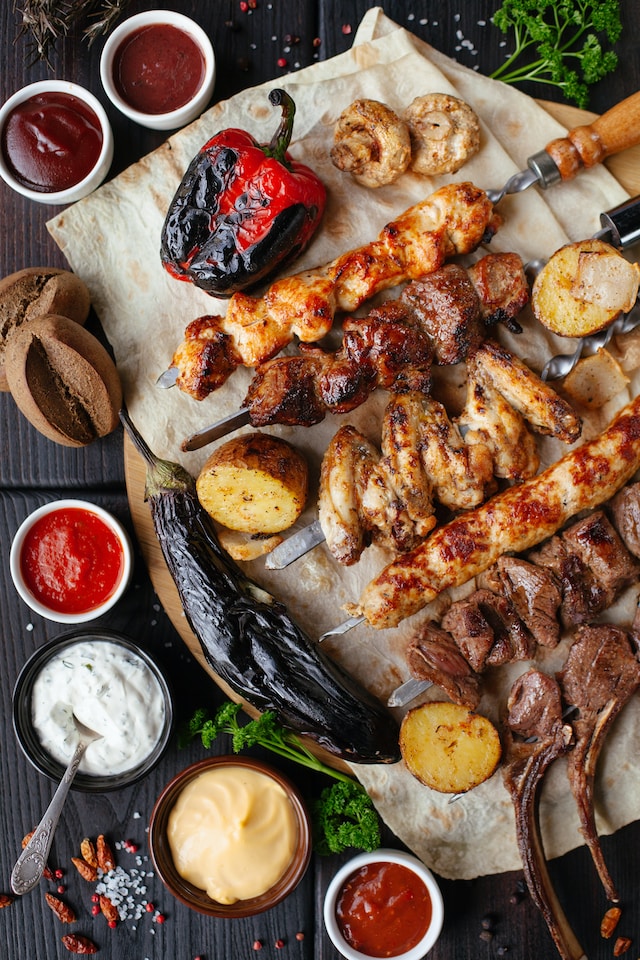Unveiling the Art of Persian Kebabs
Persian Kebabs are a popular cultural dish among the people of Persia and the Middle East and are often served at gatherings and celebrations. Its name prominently graces the menus of most Iranian restaurants.
This dish, introduced to Iran during the Qajar era under the rule of Naser al-Din Shah, has transformed since its arrival, presenting a diverse array of preparations today.
Various types of red and white meats are used in its preparation. In the following sections, you’ll become acquainted with different Persian kebabs.
Understanding the Essence of Persian Kebabs
Embark on our exploration of Persian kebabs with a focus on the basics. Hailing from Iran, these kebabs are renowned for their careful preparation and delightful blend of flavours.
Skewering and grilling meats have been a longstanding tradition in Persian culture, spanning centuries. Nowadays, Persian kebabs have gained worldwide attention, captivating taste enthusiasts globally with their deliciousness and cultural importance.

Choosing the Right Persian Kebab Ingredients
At the core of every delicious dish are its ingredients, and Persian kebabs are no different. While lamb is a popular choice in Iran, beef and chicken are also common, offering options for various tastes. Persian spices like saffron, turmeric, sumac, and cumin bring a unique flair to these kebabs. Fresh herbs like mint and parsley provide a touch of freshness, enhancing the flavours to perfection.
Mastering the Marinade Magic
In the heart of Persian kebabs, there’s a special mix—the marinade. Blending yoghurt, minced garlic, grated onion, and various spices, this marinade not only makes the meat tender but also adds rich layers of flavour.
Letting the meat soak in the marinade for an extended time, preferably overnight, guarantees a flavour-packed experience that truly reflects the art of Persian cooking.
Crafting the Perfect Skewer Technique
In Persian cooking, skewering is an art that combines precision and beauty. The classic flat skewers, known as “souvlaki,” give the kebabs a distinct shape.
When placing the pieces on the skewers, alternate between tasty, marinated meat and vibrant veggies like bell peppers and onions. This careful setup not only makes it look good but also ensures even cooking.
Persian Kebab Cooking Methods
Grilling over an open flame is the classic way, but Persian kebabs are flexible and can be cooked in various ways.
Whether on a charcoal grill, in an oven, or on a stovetop grill pan, the goal is to get that smoky flavour reminiscent of traditional Persian grilling. A bit of smoky paprika or mesquite wood chips can boost the smokiness in non-traditional cooking setups.
Perfecting the cooking time
Making the ideal Persian kebab is all about cooking expertise. Cook on medium-high heat for 10–15 minutes, turning the skewers now and then.
The goal is a golden brown outside that seals in the meat’s juiciness and tenderness. This delicate balance guarantees a culinary delight for your taste buds.
Serving Suggestions for Persian Kebabs
As you savour your Persian kebabs, let’s explore the art of presentation and pairing. A typical Persian spread features fluffy saffron-infused rice, or “chelow,” served alongside the kebabs.
A lively side salad with diced tomatoes, cucumbers, and red onions provides a refreshing contrast. Enhance the kebabs with a scoop of creamy tzatziki, or Persian yoghurt, crafting a delightful blend of textures and flavours.
Top it off with fresh herbs like cilantro and mint for a finishing touch that enhances both the visual and taste experiences.

Types of Persian Kebabs
Iranian kebabs come in various forms, prepared with different types of meat and vegetables, and are often served as a festive meal. Lamb and chicken are the primary ingredients in Iranian kebabs. Let’s explore some of the most popular varieties:
Sultani Kebabs
Sultani Kebab is a combination of Barg and Koobideh kebabs. While it can be made with either lamb or veal, the true taste comes from using lamb.
Barg is made by grilling thin strips of meat, typically lamb, with onions and bell peppers, seasoned with spices like pepper and saffron.
Koobideh, on the other hand, uses ground lamb mixed with salt, pepper, and saffron.
Ghegheh Kebabs
Ghegheh Kebab combines beef and chicken, offering a simultaneous taste of both types of meat.
Cubes of veal and chicken breast are cut into small cubes and marinated in a sauce made with olive oil, yoghurt, onions, bell peppers, and black pepper. This kebab is an ideal choice for those who enjoy both white and red meats.
Chenjeh Kebabs
Chenjeh Kebab, a favourite among many, is made from boneless lamb leg meat. Its appearance lacks a specific order, allowing it to be cooked without skewers directly on a grill or metal grate.
The ingredients include lamb, pepper, lemon juice, and olive oil. Chenjeh kebab is often served with rice, grilled tomatoes, and raw onions.
Bakhtiari Kebabs
Bakhtiari Kebab, a popular Iranian party dish, is made with chunks of chicken and lamb fillets.
The meat is marinated with onions, bell peppers, lemon juice, saffron solution, and black pepper. After resting in the refrigerator for 12 hours, it achieves the desired taste and flavour.
Barg Kebabs
Barg kebab is so tender that it can easily be cut with a fork! One of Iran’s most popular kebabs, it is made with either lamb or veal.
To prepare this kebab, the meat is softened with onions and seasoned with saffron. The added onions play a crucial role in making the meat tender and flavourful.
Koobideh Bonab Kebabs
Koobideh Bonab Kebab is an ancient Azerbaijani dish and one of the Iranian kebab varieties.
The key feature of this kebab is its minced fresh lamb meat, which is almost twice the size of regular Koobideh kebabs. The secret lies in finely chopping the onions and skilfully skewering the kebab.
Torsheh Shomal Kebabs
Torsheh Shomal Kebab is a local dish from Gilan Province.
Made with veal or lamb, it combines pomegranate paste or sour orange paste with crushed walnuts. While widely popular in northern regions, variations exist depending on the local greens used.
Saffron Chicken Koubideh Kebabs
Saffron Chicken Koubideh Kebab emerged as a cost-effective option amid rising meat prices.
Despite its affordability, this kebab can be delicious and popular, especially when prepared with a special saffron technique. Using a combination of chicken thighs and breasts ensures tenderness.
Shishlik Kebabs
Shishlik kebab, a delicious treat made from veal or lamb, is essentially the same as Dande kebab.
To add flavour to the skewers, mix onions, spices, and lemon juice. Eating Dande kebab, another famous and luxurious dish, is delightful due to the presence of bone, adding a touch of charm to the experience.

Embarking on a Cooking Adventure with Persian Kebabs
In the kitchen, every dish we make has a story, and Persian kebabs tell a tale of age-old cooking traditions that have travelled across the world.
As a beginner, enjoy the journey, savour the smells, and delight in making a dish that takes you to Iran and connects you to a global culinary history. With this guide, you’re on a cooking adventure – one that offers not just a meal but a mix of flavours that dance in your mouth. Happy cooking!
